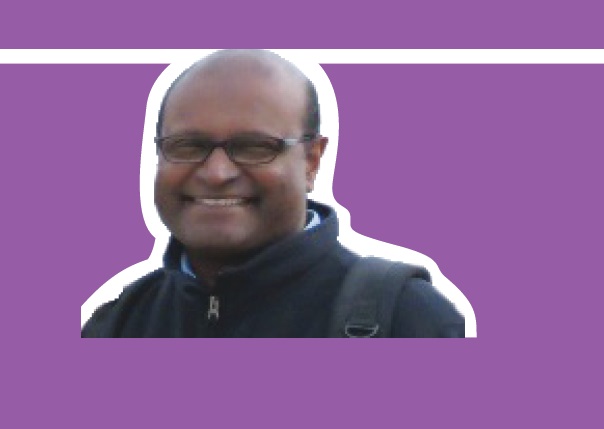Towards freedom in Lent
The light of Christ that comes to us through the Easter candle brings light to the church, and leads us into the second part of the liturgy, namely, the proclamation of the Scriptures.
Mar 15, 2024

Canvas - Fr Richard Anthonysamy, SJ
The Greek philosophers saw the human person as consisting of body and spirit. Some schools, e.g. the Pythagoreans, for example, believed the spirit was trapped in the body. The body was like a tomb. Thus, the spirit constantly strove to free itself. The struggle for freedom is experienced in feelings of restlessness, frustration, inner turmoil, etc. It is not uncommon for each of us to experience moments when our soul wants to do one thing but the body pulls in a different direction. We notice an inner conversation enveloped in feelings of restlessness, sometimes fleeting and at other times, controlling. Yes, a conversation, a self-talk nuancing the desire to be set free.
In his Message for Lent 2024 entitled Through the Desert God leads us to Freedom, Pope Francis elaborates about the journey to freedom God wants to take us through. The Lenten journey is a journey towards spiritual freedom. Our spiritual self-discipline should awaken us to the areas in our life where we remain entrapped or enslaved. It should enable us to get beyond the surface. That Lent is a season with lasts more than a month and not just a day or a week is a clear indication that Lent is a journey. Pope Francis recalls the 40 years the Israelites were in the desert. It was a journey through the desert that led to freedom.
We could embrace and participate in the road to freedom during Lent in two ways. Every season of Lent, the faithful are called to repentance. The prophet Joel (2:12-18) exhorts us to a journey of change and transformation (1st reading on Ash Wednesday). This journey is to be made individually and communally. In the Catholic Church, parishes increase time set aside for the Sacrament of Reconciliation (Confession). The first way to embrace and participate in the road to freedom during Lent is to prepare well for Confession.
In the Spiritual Exercises of St Ignatius, paragraphs 55-61 are dedicated to a meditation on our sins. In paragraph 56- 57, St Ignatius invites the retreatant to understand his or her sins by taking note of the place where it (the sin) happened, the dealings with people he or she may have had, and the office or position he or she may have occupied. In short, we are being made to see the context in which a particular sin was committed. We are asked to note the people involved, and the dynamics of power. This is not to mitigate the sin or rationalise it away. Rather, it is to have a growing awareness of how this sin came about (and probably continues to be present in one’s life).
Too often people share that they do not understand why they are struggling with certain sins. For some, the awareness that they keep repeating a particular sin leads them to feel discouraged and even doubt in the mercy of God. And the devil is most delighted to encourage us in the path of discouragement and doubt.
However, taking time to prepare before Sacramental Reconciliation by contextualising it brings about awareness. With awareness, we can work towards changing the direction of, or life in relation, to that sin. As my Jesuit novice director once said, “If you see a dog lying quietly by a gate but with a big chain around it’s neck, that should tell you what precautions you need to take.” Yes, proper preparation will lead to better awareness and a more meaningful confession and repentance. And this, in turn, lead to freedom. This is the first way.
The second way we are moved towards freedom is to embrace the path offered to us by God. It is the light from the Word of God. Turning away involves turning towards something. On Easter vigil night, at the beginning of the liturgy, the entire church is in darkness. A fire is lit and from its flames the new Easter candle is lit. And that light is processed into the darkness, and from the flame of that candle, the other candles are lit. A new light enters the church. We begin to see again, slowly but surely. The light of Christ both draws our attention, and it works to enlighten us. The second way to freedom involves allowing the light to come us. It involves accepting the light by looking to it even as we eagerly await our own candles to be lit. To the Israelites who journeyed through the desert, the light of God given them was the Ten Commandments. This was to be their sure path of freedom, more than any geographical land. Embracing and living the commandments would guide and shape them into a people. It would provide them the light of life.
The light of Christ that comes to us through the Easter candle brings light to the church, and leads us into the second part of the liturgy, namely, the proclamation of the Scriptures. Put another way, as soon as light is given, we are being directed to the Word of God. There we find the second way to freedom, just as the Israelites did through the Ten Commandments. Our ongoing path to freedom will be intimately related to our embracing of the proclaimed Word.
May our journey to freedom be indeed a freeing experience.
(Fr Richard Anthonysamy SJ is involved in parish ministry, spiritual direction, and faith formation work.)







Total Comments:0